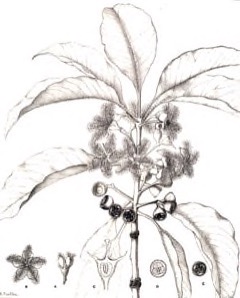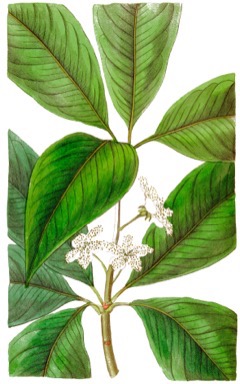 |
|
http://www.edibleplants.org |
 |
| http://www.edibleplants.org |
Translate this page:
Summary
Found in Australia, Lophostemon confertus or commonly known as Vinegar Tree is a fast-growing tree used as a pioneer species for re-establishing woodland. It grows up to 40 m in height. The bole is straight, cylindrical, and can be up to 300 cm in diameter. The bark yields tannins. The wood is very strong and very durable, and usually used in shipbuilding, making bridges, floors, wooden tram rails, and as a general building timber.
Physical Characteristics

 Lophostemon confertus is an evergreen Tree growing to 30 m (98ft) by 20 m (65ft) at a fast rate.
Lophostemon confertus is an evergreen Tree growing to 30 m (98ft) by 20 m (65ft) at a fast rate.
See above for USDA hardiness. It is hardy to UK zone 10 and is frost tender. The flowers are pollinated by Bees.
Suitable for: medium (loamy) and heavy (clay) soils and can grow in heavy clay soil. Suitable pH: mildly acid and neutral soils and can grow in very acid soils.
It can grow in semi-shade (light woodland) or no shade. It prefers moist soil and can tolerate drought.
UK Hardiness Map
US Hardiness Map
Synonyms
Lophostemon arborescens Schott Melaleuca conferta (R.Br.) Steud. Tristania conferta Griff. Tristania
Plant Habitats
Edible Uses
References More on Edible Uses
Medicinal Uses
Plants For A Future can not take any responsibility for any adverse effects from the use of plants. Always seek advice from a professional before using a plant medicinally.
None known
References More on Medicinal Uses
The Bookshop: Edible Plant Books
Our Latest books on Perennial Plants For Food Forests and Permaculture Gardens in paperback or digital formats.

Edible Tropical Plants
Food Forest Plants for Hotter Conditions: 250+ Plants For Tropical Food Forests & Permaculture Gardens.
More

Edible Temperate Plants
Plants for Your Food Forest: 500 Plants for Temperate Food Forests & Permaculture Gardens.
More

More Books
PFAF have eight books available in paperback and digital formats. Browse the shop for more information.
Shop Now
Other Uses
Tannin Wood
Shade tree. Street tree. Specimen. Public open space. Large planter. Conservatory. Agroforestry Uses: A fast-growing tree, able to cope with a wide range of soils and climates, it is a good pioneer species for re-establishing woodland[694 ]. Other Uses The bark is a source of tannins[517 , 601 ]. The wood is pale in colour, sometimes brown, it turns grey on exposure. It is very strong, very durable and unlikely to be attacked by white ants[601 , 694 ]. When polished, it has a very pretty grain[601 ]. On aging, it becomes extremely hard and blunts saws[156 ]. It is difficult to season - planks and slabs of the wood crack, warp, twist, and shell in the most extraordinary manner, unless the greatest care be exercised both in the time of cutting of the timber and the seasoning[601 ]. It is used in shipbuilding; for making wharves and bridges; as a general building timber, particularly for floors and weatherboards; mallets, chisel handles, planes etc[46 , 517 , 601 ]. It was used extensively as wooden tram rails, becoming polished and very hard with use[156 ]. Ribs of vessels made from this tree have remained unimpaired for thirty years and more[601 ].
Special Uses
References More on Other Uses
Cultivation details
A plant of the subtropics to the tropics, where it is found at elevations up to 800 metres. It grows best in areas where annual daytime temperatures are within the range 18 0 28°c, but can tolerate 10 - 36°c[418 ]. When dormant, the plant can survive temperatures down to about -5°c, but young growth can be severely damaged at -1°c[418 ]. It prefers a mean annual rainfall in the range 1,100 - 1,500mm, but tolerates 900 - 1,700mm[418 ]. Succeeds in full sun to partial shade[423 ]. Requires a well-drained, fertile soil[423 ]. Succeeds in sandy to clayey soils[418 ]. Prefers a pH in the range 5 - 6.5, tolerating 4.5 - 7[418 ]. The tree has escaped from cultivation in Hawaii and become invasive[305 ]. Very tolerant of hard and repeated pruning[200 ]. Flowering Time: Mid Spring Late Spring/Early Summer. Bloom Color: White/Near White. Spacing: 15-20 ft. (4.7-6 m) 20-30 ft. (6-9 m).
References Carbon Farming Information and Carbon Sequestration Information
Temperature Converter
Type a value in the Celsius field to convert the value to Fahrenheit:
Fahrenheit:
The PFAF Bookshop
Plants For A Future have a number of books available in paperback and digital form. Book titles include Edible Plants, Edible Perennials, Edible Trees,Edible Shrubs, Woodland Gardening, and Temperate Food Forest Plants. Our new book is Food Forest Plants For Hotter Conditions (Tropical and Sub-Tropical).
Shop Now
Plant Propagation
Seed - very small, it is best mixed with fine sand when sowing. It germinates easily.
Other Names
If available other names are mentioned here
Vinegar Tree, Brisbane Box, Brush Box, Queensland Box
Native Range
AUSTRALASIA: Australia (New South Wales (east), Queensland (east))
Weed Potential
Right plant wrong place. We are currently updating this section.
Please note that a plant may be invasive in one area but may not in your area so it's worth checking.
Conservation Status
IUCN Red List of Threatened Plants Status : This taxon has not yet been assessed

Growth: S = slow M = medium F = fast. Soil: L = light (sandy) M = medium H = heavy (clay). pH: A = acid N = neutral B = basic (alkaline). Shade: F = full shade S = semi-shade N = no shade. Moisture: D = dry M = Moist We = wet Wa = water.
Now available:
Food Forest Plants for Mediterranean Conditions
350+ Perennial Plants For Mediterranean and Drier Food Forests and Permaculture Gardens.
[Paperback and eBook]
This is the third in Plants For A Future's series of plant guides for food forests tailored to
specific climate zones. Following volumes on temperate and tropical ecosystems, this book focuses
on species suited to Mediterranean conditions—regions with hot, dry summers and cool, wet winters,
often facing the added challenge of climate change.
Read More
Expert comment
Author
(R.Br.) Peter G.Wilson & J.T.Waterh.
Botanical References
Links / References
For a list of references used on this page please go here
A special thanks to Ken Fern for some of the information used on this page.
Readers comment
| Add a comment |
|
If you have important information about this plant that may help other users please add a comment or link below. Only comments or links that are felt to be directly relevant to a plant will be included. If you think a comment/link or information contained on this page is inaccurate or misleading we would welcome your feedback at [email protected]. If you have questions about a plant please use the Forum on this website as we do not have the resources to answer questions ourselves.
* Please note: the comments by website users are not necessarily those held by PFAF and may give misleading or inaccurate information.
To leave a comment please Register or login here All comments need to be approved so will not appear immediately.
|
Subject : Lophostemon confertus
|
|
|
|